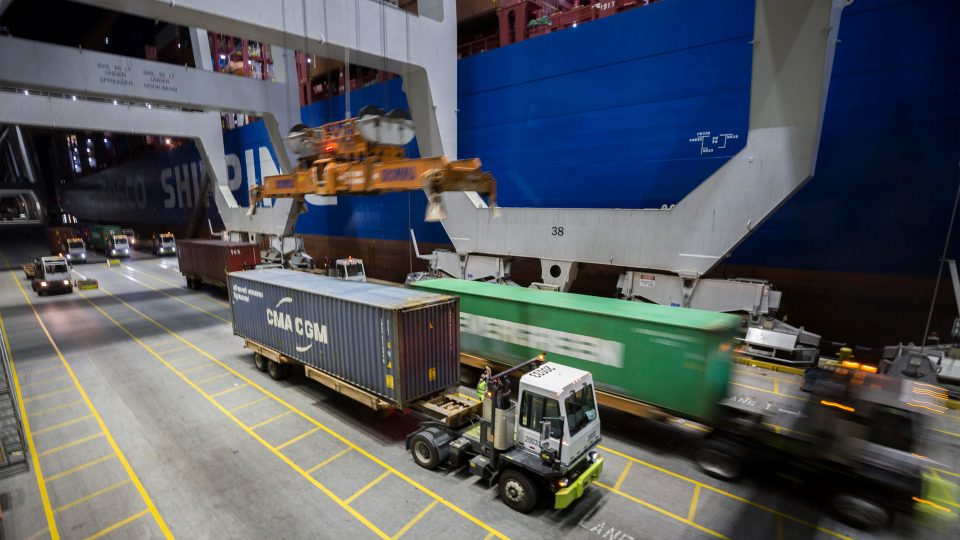It’s a tale of two oceans for U.S. container imports. Freight rates for Asian exports crossing the Pacific are reaching new heights even as fleet capacity rebounds. Rates for boxes from Europe crossing the Atlantic are sliding even as more ships are pulled from service.
Prior to the coronavirus, the secular shipping pendulum was swinging toward the East Coast ports. Now, the pendulum is swinging back — at least temporarily. The West Coast is seizing a bigger share of U.S. imports in the COVID era.
U.S. importers sourcing goods in Asia are opting for faster transits to California as opposed to the long route via the Panama Canal to ports on the Atlantic coast. Simultaneously, the East Coast share is being curbed by lower flows from Europe.
The East-West split has significant implications for land transport. The more cargo unloaded at the docks in the West, the better for rail and the worse for trucking, and vice versa.
Asian cargo unloaded in California and destined for Eastern states creates more rail volume eastward. Asian cargo unloaded in the East and destined for Eastern states leads to fewer rail miles eastward and more trucking miles westward.
What ocean rate data shows
The Freightos Baltic Daily Index — which estimates the cost to ship a forty-foot equivalent unit (FEU) container — reveals how the markets are diverging.
Since the beginning of March, when freight markets were particularly weak, the cost per FEU to ship from Asia to the West Coast (SONAR: FBXD.CNAW) has more than doubled. The cost from Asia to the East Coast (SONAR: FBXD.CNAE) is up by a third. But the cost from Europe to the East Coast (SONAR: FBXD.ENEA) is down by 2%.

What customs and rail data reveal
This year’s swing to the West is clearly visible in data on the number of customs filings for maritime imports (each filing can be for any cargo volume).
Looking at the seven-day trailing average of daily filings since March 1, the number of customs forms has almost quadrupled in Long Beach, California (SONAR: ICSTM.USLGB). It has more than doubled in Los Angeles (SONAR: ICSTM.USLAX). In sharp contrast, the customs numbers are unchanged in New York/New Jersey (SONAR: ICSTM.USNYC) and are down 2% in Savannah, Georgia (SONAR: ICSTM.USSAV).

The rail data tells the same story. Since March 1, 40-foot loaded containers on rail from Los Angeles to Chicago (SONAR: ORAIL40L.LAXCHI) are up 64%. Volumes from New Jersey to Chicago (SONAR: ORAIL40L.EWRCHI) are up only 6%.

Trouble on the Atlantic
“The Europe-North America trade is not yet enjoying increased cargo demand,” said Alphaliner in its latest weekly newsletter. “Whereas most blanked [canceled] sailings have already been reinstated on the trans-Pacific … more void sailings have already been announced for the trans-Atlantic trade.”
Alphaliner reported that weekly Europe-North America capacity was down 4.8% in July versus the same month last year. “MSC and Maersk have made the biggest efforts to reduce capacity,” said Alphaliner, referring to the partners in the 2M alliance, which has temporarily halted one of its four North Europe-East Coast loops.

The Europe-U.S. rate had fallen to $1,785 per FEU on Tuesday, down 8% its COVID-era high on June 7, according to Freightos data.
The fact that trans-Atlantic rates are sliding at the same time ship capacity is declining underscores that transport demand is falling.
“The crisis on the westbound trans-Atlantic is getting worse,” warned Steve Ferreira, founder and CEO of Ocean Audit.
“Shipments of wine are always one of the bellwethers of westbound trans-Atlantic trade health,” he explained to FreightWaves. Imports of wine from Italy, France Spain and Portugal were down 24% in May-July versus the same period last year, he said. Overall container volumes were down 18%.
“The wine drop is especially alarming considering the pandemic and the increase in alcohol sales, meaning the consumer is shifting to other types of alcoholic beverages. And as for auto parts [shipped trans-Atlantic] – forget it,” said Ferreira, noting that auto-parts volumes in May-July were just a third of levels seen a year ago.
Booming rates on trans-Pacific
In the trans-Pacific, almost all of the capacity that carriers blanked in the second quarter has been put back into service in the third. Despite more ship capacity, rates are rising.
Rates climbed through June and the first week of July, then pulled back slightly through the rest of the month. Then they bounced up again in the first few days of August, following the fourth general rate increase (GRI) since early June.
Asia-West Coast rates had risen to $2,764 per FEU as of Tuesday, according to Freightos.

Freightos Chief Marketing Officer Eytan Buchman commented, “These elevated rates are quite surprising, as capacity is back to near normal and volumes are actually projected to be down.” He said rates “point to how unprecedented the current environment is for ocean freight.”
“The rebound in demand that started in June continues to keep rates up,” continued Buchman, who added that “demand is keeping ships out of China very full, with carriers able to charge premiums to prevent shipments from being rolled.”
To some extent, current demand could be borrowing from the future. According to Buchman, “Some industry insiders are predicting that this year’s version of peak season will last only through September and will focus on stay-at-home goods like furniture, kitchenware and electronics.” Click for more FreightWaves/American Shipper articles by Greg Miller


